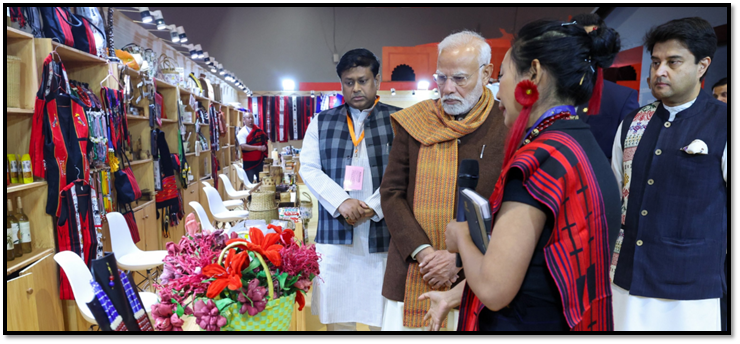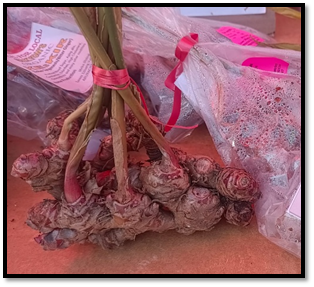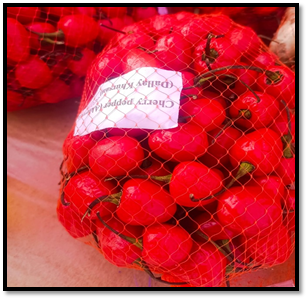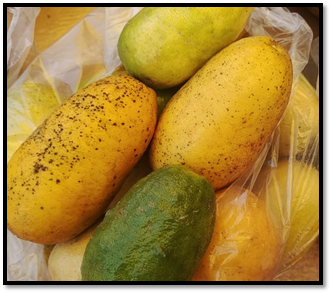Ministry of Development of North-East Region
From Spices to Sustainability
Unveiling North East India’s Agricultural Treasures
Posted On: 09 DEC 2024 6:29PM
“We are connecting the North East with the trinity of Emotion, Economy and Ecology”
~Prime Minister Shri Narendra Modi

In the vibrant tapestry of North East India, where tradition and progress intertwine, Ashtalakshmi 2024 emerges as a celebration of culture, craftsmanship, and empowerment. The event brings together the eight diverse states of the region, each showcasing its unique treasures—handwoven textiles, organic produce, and aromatic spices. But beneath the beauty of these handcrafted products lies a deeper story of resilience and heritage, guided by the vision of Prime Minister Narendra Modi for a prosperous future.
During Ashtalakshmi 2024, PM Modi emphasized how North East India, with its abundant natural resources and strong commitment to organic farming, is uniquely positioned to drive India’s vision for a healthier and more sustainable future. From millet and rice to bamboo and spices, these precious resources are more than just products—they embody the region’s rich identity and potential.
The Geographical Indication (GI) tag, which protects and celebrates these treasures, is empowering local communities and ensuring that North East India's cultural heritage thrives on a global stage. Through this recognition, these products are not only preserved but also given the opportunity to shape the region’s future, creating new pathways for growth and prosperity.

In Arunachal Pradesh, the Adi Kekir ginger, grown in the Dibang Valley, tells a story of traditional knowledge passed down through generations. Cultivated by the Adi tribe, this aromatic ginger is renowned for its medicinal properties, aiding in everything from digestive issues to menstrual pain. Its distinct aroma and healing qualities have made it a sought-after commodity, both in culinary and medicinal circles. The Adi tribe’s deep connection to the land ensures that each harvest is handled with care, keeping alive the age-old practices of organic farming. Along with this revered ginger, products like Wakro Orange and Monpa Maize have earned the prestigious GI tag, ensuring that these agricultural gems gain recognition not only across India but on the global stage.

Across the border in Sikkim, the agricultural landscape is equally captivating. Known for its organic farming practices, the state is home to the Dalle Khursani, a fiery red pepper that has earned fame far beyond the borders of India. Grown in protected organic conditions, this pepper is revered for its pungency, used in local pickles and pastes, and even celebrated for its medicinal properties. What makes this chili so special is not just its heat but its role in the local economy, where over 5,000 families rely on it for their livelihoods. Alongside it, Sikkim Large Cardamom, Temi Tea, Sikkim Orchids, and Sikkim Orange are becoming more than just products—they’re symbols of a sustainable future. These GI-tagged products embody the vision PM Modi spoke of—connecting tradition with global markets and paving the way for sustainable economic growth.

Nagaland, famous for the Naga King Chilli or Raja Mircha, is home to one of the hottest chilies in the world. It also represents the deep connection the Naga people have to their land and cultural heritage. Cultivated with care by around 100 families, this fiery chili thrives in the high-altitude, humid climate of Nagaland, producing fruit that’s packed with both heat and flavor. The chili plays an integral part in Naga cuisine, adding spice and depth to traditional dishes. In addition to the Raja Mircha, other GI-tagged products from Nagaland include Naga Tree Tomato, Chak Hao rice, and Naga Cucumber. These products highlight the region’s agricultural potential and are becoming increasingly valuable.

In the fertile lands of Assam, the Kaji Nimu, a distinctive variety of lemon celebrated for its size, aroma, and sharp tang, reflects the state's rich agricultural heritage. Larger and more flavorful than most other lemon varieties, the Kaji Nimu is an essential ingredient in Assamese cuisine and traditional remedies. But Assam’s agricultural wealth doesn’t stop there. The state is also known for its Tezpur Litchi, Joha Rice, Bodo Keradapini spices, and Boka Chaul rice, all of which have earned GI recognition. These products not only embody the state’s rich cultural history but also serve as important economic drivers, supporting local farmers and artisans. The GI tag elevates these products, ensuring they are valued and respected both locally and internationally.
Ashtalakshmi 2024 highlighted the North East's vibrant natural and cultural heritage. With the support of the GI tag, the region's agricultural and handloom traditions are being preserved and celebrated globally. Each GI product carries its own unique story—one of sustainable farming, skilled craftsmanship, and the empowerment of local communities. As PM Modi aptly stated, the North East holds the key to India’s vision for a healthier and more sustainable future. For the farmers and artisans of the region, the GI tag is not just a mark of recognition, but a lifeline, opening doors to new opportunities and a promise of prosperity.
Reference
From Spices to Sustainability
*****
Santosh Kumar/ Sheetal Angral/ Kamna Lakaria/ Ishita Biswas
(Features ID: 153551)
Visitor Counter : 171